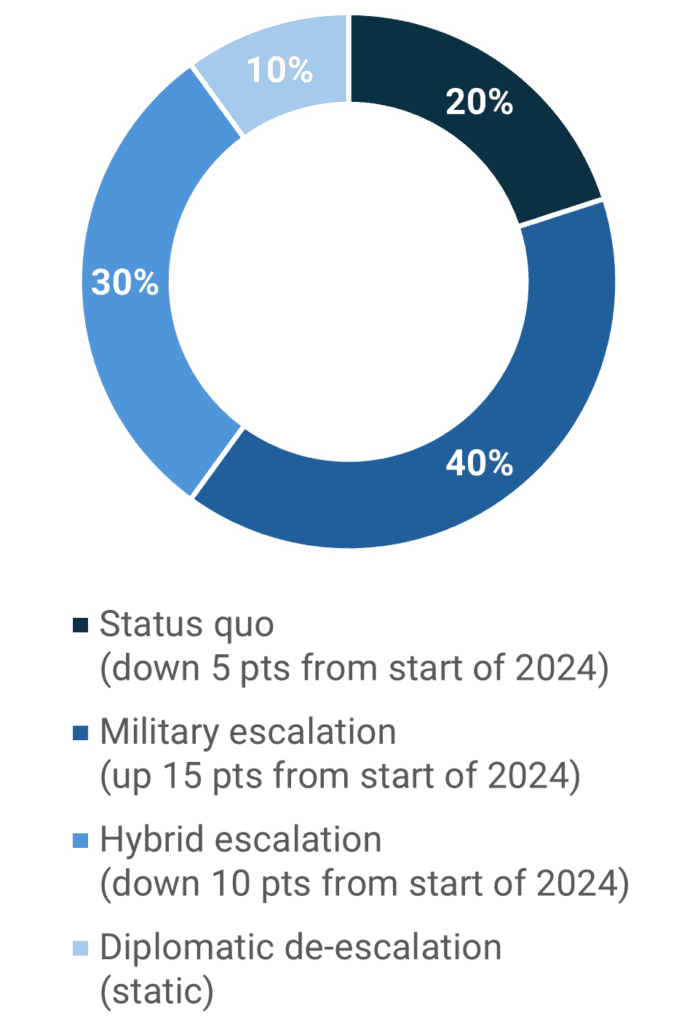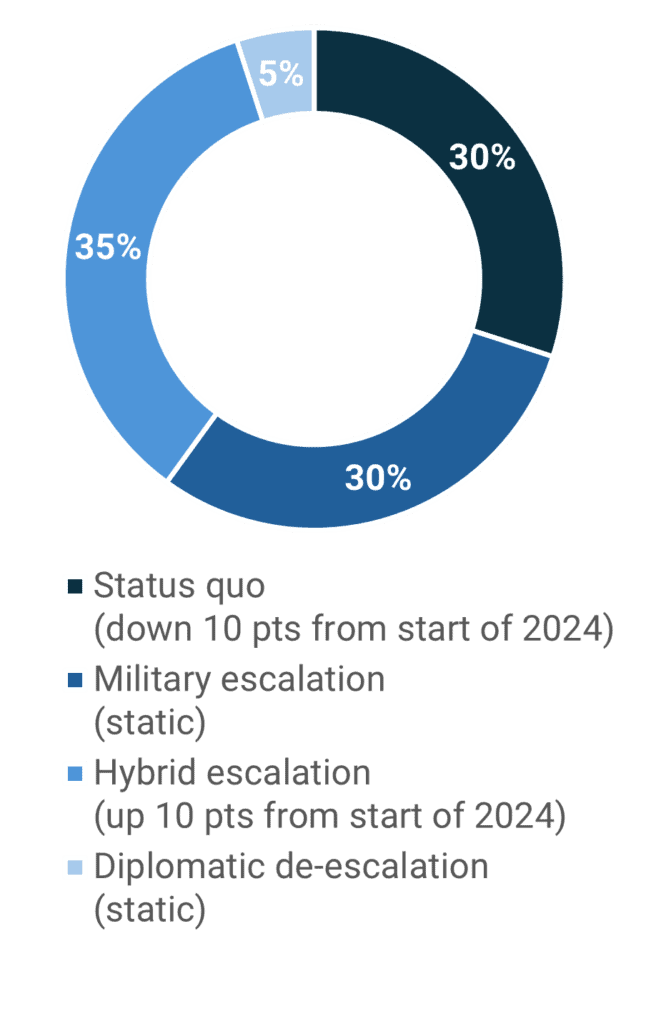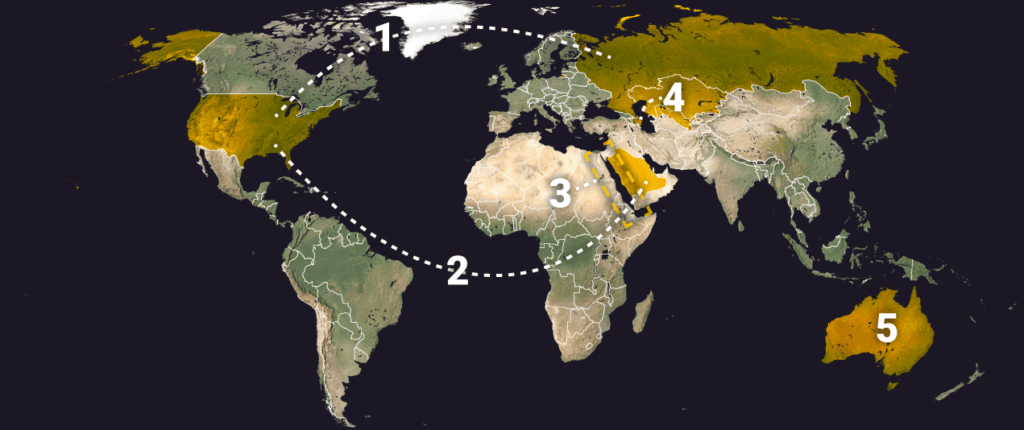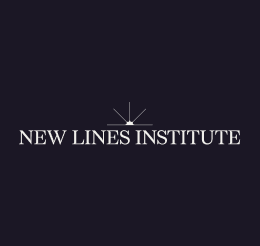The Weekly Forecast Monitor is a forward-looking assessment of geopolitical dynamics that are shaping the international system. To get more in-depth analysis of these issues and learn more about analytical products from New Lines Institute — including simulations, training sessions, and forecast reports — contact us at [email protected] and visit https://newlinesinstitute.org/analytical-products/. Download PDF version.
Global Hotspot Tracker
The Global Hotspot Tracker examines the outlook for key geopolitical hotspots around the world. (Go to the Global Connectivity Tracker)
Middle East
Summary – Tensions in the Middle East trended toward military and hybrid escalation scenarios amid Israel’s evacuation of civilians in Rafah, massing tanks and bombarding the city, and seizing control of Rafah border crossings with Egypt. Combat and shelling between Israel and Hezbollah intensified, and the U.S announced it would pause ammunition and bomb shipments to Israel. Cease-fire negotiations between Hamas and Israel stalled, with Hamas saying it has no intentions of budging from a proposal already rejected by Israel.

Military escalation scenario
- The Israeli military massed tanks and encircled east of Rafah, seized control of Rafah border crossings with Egypt, and intensified its bombardments, causing civilian casualties.
Risk level – high - Israeli bombardments of southern Lebanon resulted in civilian and Hezbollah casualties. Hezbollah responded with drone and missile attacks that caused multiple Israeli casualties.
Risk level – medium/high
Hybrid escalation scenario
- The U.S. paused weapons shipments to Israel ahead of its planned Rafah offensive while awaiting the State Department’s report on whether Israel violated international law in its Gaza offensive.
Risk level – medium/high - Spain, Ireland, and other EU member states are considering recognizing the Palestinian state on May 21.
Risk level – low/medium - The U.N. General Assembly could vote on a draft resolution to recognize the Palestinians as qualified to become a full U.N member.
Risk level – low/medium
Diplomatic de-escalation scenario
- Hamas leaders held talks with Egyptian and Qatari mediators after announcing the group had accepted a cease-fire deal, though Israel subsequently rejected the terms of that cease-fire.
Opportunity level – low
Russia/Ukraine Conflict
Summary – The Russia-Ukraine conflict is trending toward military and hybrid escalation scenarios as Russia launched an armored attack on Kharkiv and announced plans for tactical nuclear weapons exercises in response to Western threats to the country. Russia and Ukraine ramped up attacks against each other’s energy infrastructure, with Ukraine attacking an oil refinery in the Russian region of Bashkortostan for the first time. Russian President Vladimir Putin was officially inaugurated for his fifth term, and he warned against the risk of global conflict during his annual Victory Day speech in Moscow.

Military escalation scenario
- Russia plans to hold military exercises that simulate the use of tactical nuclear weapons in response to “provocative statements and threats of certain Western officials regarding the Russian Federation,” according to the Russian Defense Ministry.
Risk level – medium - Russian forces launched an armored ground attack on Kharkiv and attempted to break through Ukraine’s defensive lines. Ukrainian forces repelled the attack.
Risk level – medium - Lithuanian Prime Minister Ingrida Šimonytė said the country was prepared to send troops to Ukraine on a training mission, despite Russia’s threats of tactical nuclear weapons exercises.
Risk level – low
Hybrid escalation scenario
- Russian attacks against Ukrainian energy infrastructure damaged three Ukrainian thermal power plants, leading to power outages and energy rationing.
Risk level – medium - Ukraine conducted a drone attack against an oil refinery in the central Russian republic of Bashkortostan, the first time it has attacked the region since the war started.
Risk level – low - A South Korea-stationed U.S. Army soldier was detained in Russia in relation to a “purely domestic crime,” not “politics or espionage,” according to the Russian Foreign Ministry.
Risk level – low
Diplomatic de-escalation scenario
- A Ukraine peace summit will be held in Lucerne, Switzerland, June 15 and 16, but Russian officials will not be present.
Opportunity level – low
U.S./China/Indo-Pacific
Summary – Tensions in the Indo-Pacific trended toward both military and hybrid escalation scenarios. A confrontational incident between China and Australia occurred in the Yellow Sea. Taiwanese legislators will attend military drills on Taiping Island just before the inauguration of Lai Ching-te as president, and there are warnings of Chinese hacking attempts during the inauguration. Chinese President Xi Jinping conducted a diplomatic tour of Europe with stops in France, Serbia, and Hungary. The U.S. is set to unveil new tariffs against China next week.

Military escalation scenario
- A Chinese fighter jet dropped flares in the path of an Australian military helicopter during an operation in the Yellow Sea to enforce sanctions against North Korea in an incident Australian officials labeled as “unsafe” and “unacceptable.”
Risk level – medium - Germany dispatched two warships to the Indo-Pacific, tasked with ensuring freedom of navigation in the South China Sea and possibly the Taiwan Strait amid tensions between China and Taiwan.
Risk level – low - Taiwanese legislators will visit Taiping Island to observe military drills on May 18, two days before Lai’s inauguration.
Risk level – low
Hybrid escalation scenario
- Security sources warned of a potential Chinese cyberattack against Taiwan’s communications networks during Lai’s inauguration.
Risk level – medium - U.S. President Joe Biden is set to unveil new tariffs against Chinese goods, including electric vehicles, batteries, and solar cells. The U.S. added new Chinese entities to its sanctions list related to the 2023 spy balloon incident.
Risk level – medium
Diplomatic de-escalation scenario
- Philippine President Ferdinand Marcos Jr. said the country would not use offensive weapons such as water cannons in the South China Sea to avoid raising tensions with China. The country’s national security adviser called for Chinese diplomats to be expelled over the incident.
Opportunity level – low
Global Connectivity Tracker
The Global Connectivity Tracker examines the impact of geopolitical dynamics on global energy security and the climate transition. (Go to the Global Hotspot Tracker)

Energy/Climate
- United States/Russia: Uranium
What happened: President Joe Biden plans to sign a bill passed by the U.S. Senate on April 30 that would ban uranium imports from Russia, as Washington increases pressure on Moscow’s war economy.
Significance/Outlook: According to the U.S. Energy Information Administration, approximately 12% of the uranium used by U.S. nuclear power reactors in 2022 came from Russia. The United States has sought to reduce its reliance on Russian enriched uranium due to the substantial risk it poses to U.S. national security. However, if the U.S. Department of Energy determines no other feasible source of low-enriched uranium can support the ongoing operation of a U.S. nuclear power plant or reactor or if uranium imports are in the national interest, it has the power to lift the ban. This ban would be a significant step toward sanctioning Russia and would strengthen U.S. uranium fuel production and energy security.
Risk level – low/medium - United States/Saudi Arabia: Nuclear Power
What happened: The U.S. and Saudi Arabia are engaged in talks that may involve building a civilian nuclear program in Saudi Arabia in return for U.S. access to the kingdom’s uranium.
Significance/Outlook: The talks involve a potential defense pact that would give Saudi Arabia security guarantees in exchange for limiting Chinese technology use and increased U.S. investments in AI and resources. Most importantly, the deal will include sharing U.S. nuclear technology for the kingdom to build its civil nuclear program. According to some officials, this will be done without having to sign an agreement that obliges the country to renounce enrichment. The plan currently faces obstacles to adoption – the U.S. currently is pushing for Saudi normalization with Israel as part of the package, a move the kingdom is opposed to – but if adopted, it would be a breakthrough in Saudi-U.S. relations. Most importantly, it would directly feed into Saudi Arabia’s energy diversification plans.
Opportunity level – high
- Red Sea Shipping: Trade
What happened: Red Sea container shipping traffic disruptions are rising and are projected to restrict industry capacity between East Asia and Europe by 15% to 20% in the second quarter.
Significance/Outlook: Shipping companies have been rerouting their ships around the Cape of Good Hope in Africa since December to avoid attacks in the Red Sea by al-Houthi militants. As a result, freight charges and ships’ carbon emissions have been rising due to the lengthier travel times. Attacks are now reaching farther offshore, and the risk zone has grown. In addition to capacity and equipment constraints, repercussions have included congestion and vessel bunching, in which multiple ships arrive at port simultaneously.
Risk level – medium - Azerbaijan, Kazakhstan, Uzbekistan: Energy
What happened: Azerbaijan, Kazakhstan, and Uzbekistan signed a memorandum of understanding to integrate their power systems and to explore the export of green energy to Europe through the construction of a cable under the Caspian Sea.
Significance/Outlook: This agreement comes amid efforts to develop and integrate energy infrastructure among the three countries and across the Caspian Sea as an energy corridor to both Europe and China. Azerbaijan, Kazakhstan, and Uzbekistan are natural gas producers and exporters, but they also have significant potential for solar and wind power that can be channeled through a construction of an underwater cable. However, challenges to such a project will include financing and political opposition to trans-Caspian energy projects from countries like Russia and Iran.
Opportunity level – low/medium - Australia: Coal
What happened: In an effort to achieve its goal of net-zero emissions by 2050, the Australian Retirement Trust, which is responsible for managing retirement funds totaling $183 billion, will exclude thermal coal from its investments starting July 1, 2024.
Significance/Outlook: Thermal coal is the most carbon-intensive electricity generation fuel, and phasing it out is crucial to meeting Paris Agreement climate goals. Thermal coal mines and processing plants emit noise, dust, and hazardous gases. Thermal coal-fired power stations generate greenhouse gases, particulate matter, and other substances that harm people and the climate. The Australian Retirement Trust will examine its investments and exclude direct investments in coal companies with an anticipated or reported 10% coal revenue in the most recent fiscal year. This would discourage many investors from investing in fossil fuel businesses and may influence energy and power companies’ emissions reduction decisions.
Opportunity level – low
Key Stats of the Week
- Since Nov. 19, 2023, there have been more than 33 attacks on shipping vessels recorded in the Red Sea, which has become a flashpoint in geopolitical tensions as al-Houthi rebels target commercial vessels.
- Much of the world’s container trade and more than $1 trillion in yearly cargo are at risk along this route.
- The amount of trade passing through the Suez Canal decreased by 50% year-over-year in the first two months of the year, according to the high-frequency transit estimates.
- Trade passing around the Cape of Good Hope increased by an estimated 74% compared with last year.
Source: Reuters





